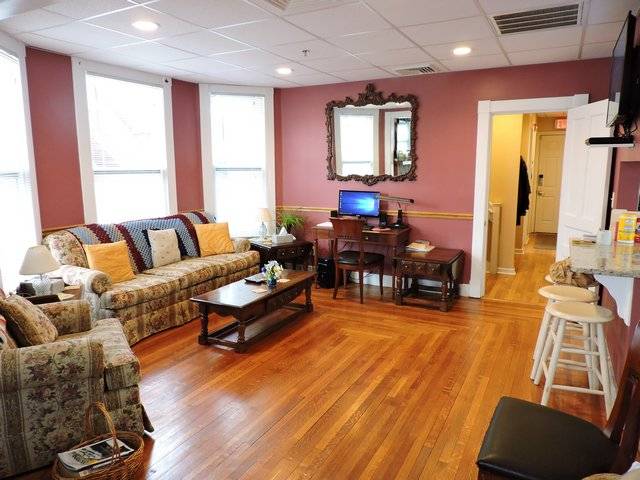Welcome to the eye-opening world of halfway houses. In this reality check, we delve into the intriguing and sometimes misunderstood life within these transitional residences. Whether you’re curious about the system or seeking information for a loved one, we’ve got you covered.
Transitioning between a correctional facility and society is no easy feat. Halfway houses serve as a stepping stone for individuals looking to reintegrate successfully into the community. These facilities aim to provide a safe and structured environment for residents, assisting them in rebuilding their lives and becoming productive members of society.

In this blog, we’ll uncover what life in a halfway house truly entails. From the daily routines and rules to the support services available, we’ll explore the challenges and opportunities that come with this transitional living arrangement. We’ll also address common misconceptions and provide insights into the realities faced by those residing in these facilities. So, if you’re ready to gain a deeper understanding of life in a halfway house and learn about the resources and support available to residents, let’s get started.
What is a Halfway House?
A halfway house, also known as a transitional residence, is a supervised living arrangement for individuals who are transitioning from a correctional facility back into society. These facilities provide a structured and supportive environment that helps residents reintegrate successfully.
Halfway houses can vary in size and structure, ranging from small homes to larger facilities with multiple residents. They are typically run by nonprofit organizations or government agencies and adhere to specific guidelines and regulations set by the authorities.
Key features of a halfway house include:
- Supportive Environment: Halfway houses offer a supportive and structured living environment where individuals can continue their journey of recovery or rehabilitation.
- Reintegration: They assist individuals in reintegrating into society by providing a safe and stable place to live while they work on rebuilding their lives.
- Accountability: Residents are often required to adhere to specific rules and guidelines, such as maintaining sobriety, attending support meetings, and actively participating in the community.
- Peer Support: Halfway houses encourage a sense of community among residents. Living with others who are in a similar transitional phase provides peer support and understanding.
- Transitional Services: Some halfway houses offer additional services, such as counseling, job placement assistance, and educational support, to help residents successfully transition to independent living.
- Structured Routine: Residents typically follow a structured daily routine, which may include job searches, attending support group meetings, and participating in house meetings.
Halfway houses play a crucial role in supporting individuals who need additional assistance and structure as they move from more controlled environments to independent living. These homes contribute to the process of rehabilitation, reducing the risk of relapse or reoffending and promoting a smoother reintegration into the community.
Living in a halfway house is not a form of punishment but rather an opportunity for individuals to receive the necessary support and resources to reintegrate into society effectively.
Purpose and Goals of a Halfway House
The purpose and goals of a halfway house are centered around providing a supportive and structured environment for individuals transitioning from more controlled settings to independent living. Here are the key purposes and goals of a halfway house:
Purpose:
- Transitional Support: The primary purpose is to offer a transitional living arrangement for individuals leaving institutional settings such as rehabilitation centers, correctional facilities, or hospitals. It serves as a stepping stone between more structured environments and fully independent living.
- Reintegration into Society: Halfway houses aim to facilitate the successful reintegration of individuals into mainstream society. This includes helping residents navigate the challenges of daily life while maintaining their commitment to recovery or rehabilitation.
- Continued Recovery: For individuals recovering from substance abuse or addiction, a halfway house provides a supportive environment where they can continue their journey of recovery. This may involve attending support meetings, participating in counseling, and avoiding triggers that could lead to relapse.
- Skill Development: Halfway houses often offer programs and resources to help residents develop essential life skills. This may include job training, educational support, and assistance in acquiring the skills needed for independent living.
- Accountability: Residents are held accountable for their actions and adherence to house rules. This accountability helps create a sense of responsibility and structure, contributing to the overall success of the transition process.
Goals:
- Sobriety Maintenance: One of the primary goals is to support individuals in maintaining sobriety or abstaining from harmful behaviors. This may involve drug testing, counseling, and peer support within the house.
- Employment and Education: Halfway houses aim to assist residents in securing employment or continuing their education. This goal promotes financial independence and enhances overall well-being.
- Community Integration: The goal is to foster a sense of community within the house and encourage residents to engage positively with the broader community. This can include participating in local activities, volunteering, or building positive social connections.
- Independent Living Skills: Helping residents develop practical skills for independent living is a key goal. This may involve budgeting, meal planning, time management, and other essential life skills.
- Reduced Recidivism: For individuals with a history of criminal involvement, reducing the likelihood of reoffending is a crucial goal. Halfway houses aim to provide a supportive environment that helps individuals break the cycle of repeated criminal behavior.
Overall, the purpose and goals of a halfway house revolve around empowering individuals to successfully navigate the challenges of transitioning from a controlled environment to independent living while promoting positive personal and behavioral changes.
The structure and rules of a halfway house
The structure and rules of a halfway house are designed to provide a supportive and structured environment for residents as they transition from more controlled settings to independent living. While specifics may vary among different halfway houses, common elements include:
1. Residential Structure:
Residents typically share bedrooms or living spaces, fostering a sense of community and peer support. Houses may be single-gender or coed, depending on the facility’s policies.
2. House Rules:
Clearly defined rules and expectations are established for all residents. Rules often cover areas such as curfew, attendance at support meetings, cleanliness, and respectful behavior toward fellow residents.
3. Mandatory Meetings:
Residents may be required to attend regular house meetings to discuss concerns, provide updates on progress, and address any issues within the community.
4. Curfew:
A set curfew is usually in place, ensuring residents maintain a structured routine and prioritize a healthy sleep schedule.
5. Employment or Education Requirements:
Residents may be required to actively seek employment or engage in educational activities as part of their transition plan.
6. Random Drug Testing:
Many halfway houses implement random drug testing to support residents in maintaining sobriety.
7. Counseling and Support:
Participation in counseling or therapy sessions may be a requirement to address underlying issues and support residents in their recovery or transition process.
8. Payment of Rent:
Residents are typically required to contribute financially by paying rent or fees, fostering a sense of responsibility and financial independence.
9. Community Engagement:
Residents may be encouraged to engage with the local community through volunteering, participating in recreational activities, or attending community events.
10. No Tolerance for Violence or Substance Abuse:
Strict policies are often in place against any form of violence or substance abuse within the house, with consequences for violations.
It’s important to note that the specific rules and structure of a halfway house can vary widely, and the house’s focus may depend on the needs of its residents, such as substance abuse recovery, reintegration after incarceration, or mental health support. Individualized plans are often developed to address the unique circumstances of each resident while fostering a supportive and accountable community environment.
Benefits of living in a halfway house
Living in a halfway house offers crucial benefits for individuals transitioning from correctional facilities. They foster community and camaraderie, promoting discipline and accountability. With access to resources like education and job placement, residents grow personally. These environments reduce the risk of relapse, aiding gradual transition to independent living and long-term success.
Challenges and potential obstacles in a halfway house
While halfway houses offer numerous benefits, they also come with challenges and potential obstacles that residents may face. It’s essential to understand these challenges to better support individuals going through the reintegration process. Some common challenges include:
- Limited personal freedom: Halfway houses have rules and restrictions that limit personal freedom, such as curfews and limitations on visitors. Adjusting to these limitations can be challenging for residents.
- Strict accountability: Residents are often subject to random drug and alcohol testing, required attendance at meetings or counseling sessions, and strict financial accountability. Adhering to these requirements can be demanding.
- Finding employment and housing: Securing stable employment and suitable housing can be challenging for individuals with a criminal record. Halfway houses provide support and resources to address these obstacles, but the process can still be daunting.
- Dealing with stigma: Individuals living in halfway houses may face judgment and stigma from society. Overcoming this stigma and building a positive self-image can be challenging.
- Managing relationships: Rebuilding relationships with family and friends can be complicated after a period of incarceration. Residents may need to navigate trust issues, communication barriers, and other challenges.
Support services and resources offered in a halfway house
Halfway houses provide a range of support services and resources to aid residents in their reintegration journey. These services are designed to address the unique needs of individuals transitioning from correctional facilities to independent living. Some common support services and resources include:
1. Counseling and therapy: Many halfway houses offer individual and group counseling sessions to address mental health issues, substance abuse, trauma, and other challenges.
2. Vocational training and education: Residents have access to vocational training programs, educational courses, and job placement assistance to develop marketable skills and increase employment opportunities.
3. Life skills development: Halfway Houses often provide workshops and classes to help residents develop essential life skills, such as budgeting, time management, conflict resolution, and communication skills.
4. Assistance with housing and employment: Case managers and staff members help residents navigate the process of securing stable housing and employment, often through partnerships with community organizations and employers.
5. Support groups and peer mentorship: Halfway Houses facilitates support groups and peer mentorship programs to foster a sense of community and provide opportunities for residents to share experiences and learn from one another.
Tips for successfully transitioning into a halfway house
Transitioning into a halfway house can be a challenging and overwhelming experience. To make this transition smoother and increase the chances of successful reintegration, consider the following tips:
- Embrace the support: Take advantage of the support services and resources available in the halfway house. Engage in counseling, vocational training, and other programs to maximize personal growth.
- Follow the rules: Adhere to the rules and regulations of the halfway house. Compliance demonstrates commitment and responsibility, making the transition process more manageable.
- Build a support network: Establish connections with fellow residents and staff members. Building a supportive network can provide encouragement, guidance, and motivation throughout the reintegration process.
- Set goals and create a plan: Define short-term and long-term goals and develop a plan to achieve them. Whether it’s finding stable employment or addressing personal challenges, having a roadmap can increase focus and motivation.
- Seek external support: Reach out to community organizations, support groups, and mentors who can provide additional guidance and resources during the transition.
Common misconceptions and stigmas surrounding halfway houses
Halfway houses often face misconceptions and stigmas that contribute to misunderstandings about their purpose and effectiveness. It’s crucial to address these misconceptions to promote a more accurate understanding of halfway houses. Some common misconceptions include:
- Halfway houses are just “soft” prisons: While halfway houses have rules and regulations, they are not prisons. They provide a supportive environment focused on rehabilitation, reintegration, and personal growth.
- Residents of halfway houses are dangerous or unsavory individuals: Halfway house residents come from diverse backgrounds and have different reasons for being in the facility. They are individuals seeking to rebuild their lives and contribute positively to society.
- Halfway houses increase crime rates in neighborhoods: Research has shown that halfway houses do not contribute to increased crime rates in neighborhoods. These facilities are designed to support successful reintegration and reduce recidivism.
- Halfway houses are a burden on taxpayers: The cost of running halfway houses is often offset by the positive outcomes they achieve. Successful reintegration reduces the financial burden on the criminal justice system and contributes to safer communities.
Case Study: Sarah’s Journey in a Halfway House
Sarah, a 28-year-old, found himself at a halfway house after completing a rehabilitation program for substance abuse. Her journey to the halfway house began with a series of struggles with addiction that strained relationships with family and friends, led to legal issues, and ultimately left him without stable housing.
Goals and Objectives:
- Maintain sobriety through regular drug testing.
- Facilitate reintegration into society by offering support in job searching and life skills.
- Provide therapeutic support for underlying issues and relapse prevention.
- Encourage community engagement through support group meetings and volunteer work.
Challenges:
- Resisting old habits and triggers to prevent relapse.
- Rebuilding strained relationships with family and friends.
- Overcoming employment struggles for financial stability.
Achievements:
- Sustained sobriety, reflecting a commitment to recovery.
- Secured employment, fostering financial stability and self-esteem.
- Restored relationships through therapy and communication.
Conclusion
In conclusion, halfway houses serve as pivotal bridges for individuals transitioning from correctional facilities to society. Sober living facilities, with their structured and supportive environments, play a crucial role in aiding residents to rebuild their lives, develop essential skills, and ultimately become productive members of society. Recognizing the nuanced realities of life within a halfway house, encompassing both challenges and opportunities is imperative for effectively supporting individuals during the reintegration process.
For those interested in exploring innovative approaches to rehabilitation and community support, Bhouses.net offers valuable insights and resources. This modern platform combines technology with community engagement, providing individuals with additional tools to navigate challenges and establish a sustainable future.
If you have further questions or seek more information about Bhouses.net, feel free to inquire and discover how it contributes to the evolving landscape of successful reintegration.










